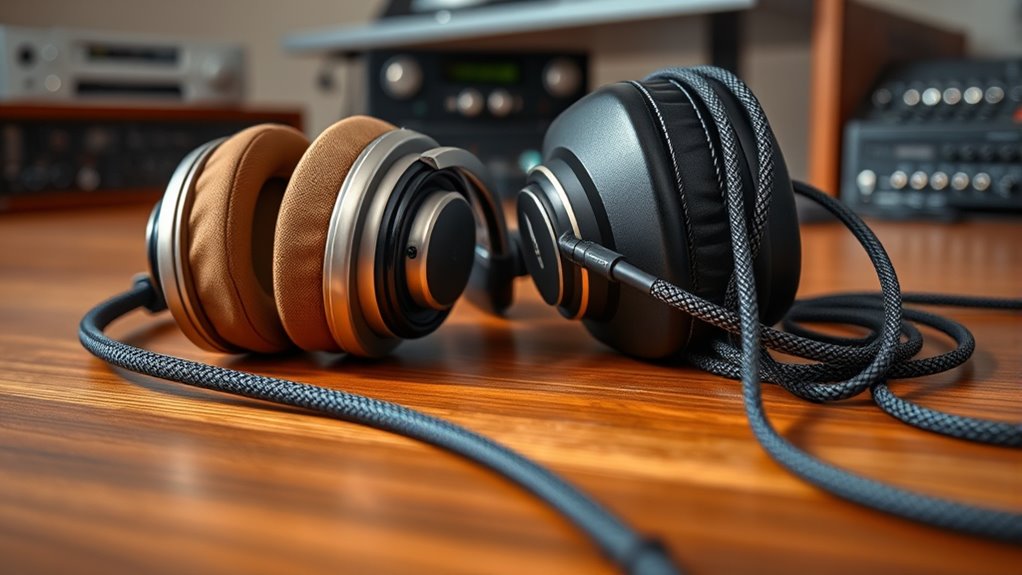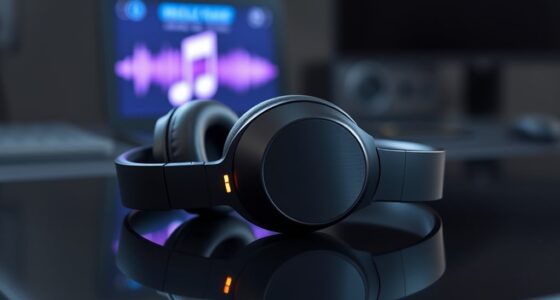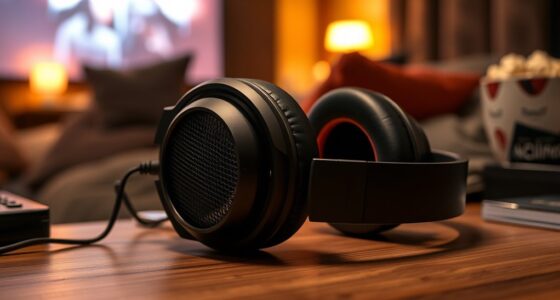Whether you need balanced or unbalanced cables for headphones depends on your setup. Balanced cables reduce noise and interference, offering clearer sound, especially over long distances or in noisy environments. Unbalanced cables are more common for casual use and are usually cheaper and easier to connect. If you want better sound quality and durability, understanding the differences can help you make the right choice—and there’s more to explore if you want to improve your audio experience.
Key Takeaways
- Balanced cables offer better noise rejection, primarily benefiting long cable runs and noisy environments, but are less common for typical headphones.
- Most consumer headphones use unbalanced connections, which are simpler, cheaper, and sufficient for casual listening.
- High-end or professional headphones may feature balanced connections for improved sound clarity and reduced interference.
- For casual or portable use, unbalanced cables are practical and cost-effective, with minimal impact on sound quality in low-interference settings.
- Overall, for standard headphone use, the difference between balanced and unbalanced cables generally doesn’t significantly affect listening experience.
Understanding the Basics of Audio Cables
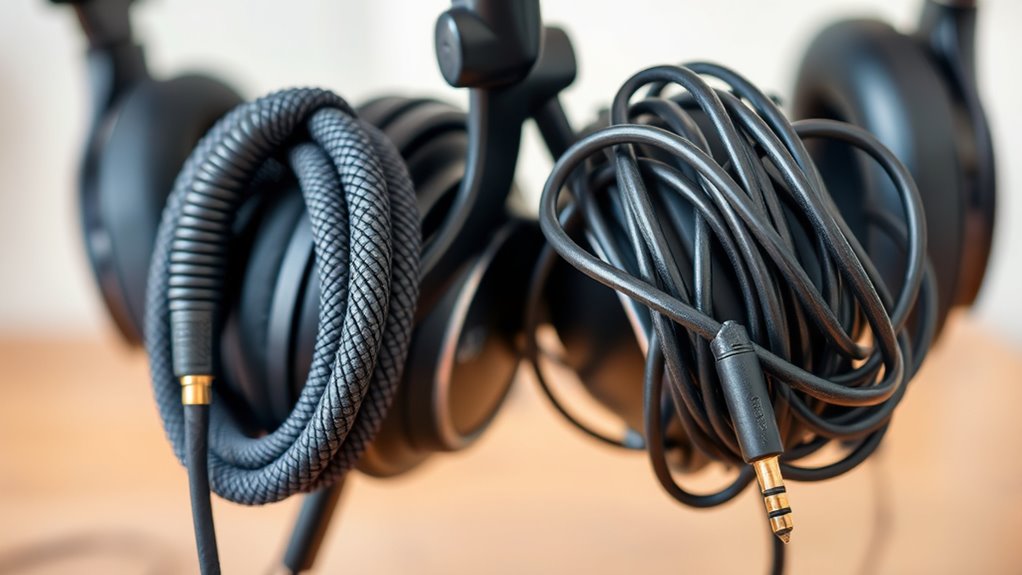
To understand the differences between balanced and unbalanced headphone cables, it’s essential to start with the basics of audio cables. Cable durability matters because sturdy cables resist wear and tear, ensuring your headphones last longer. Look for materials like braided shielding or reinforced connectors, which boost durability. Connector types also play a key role; common connectors include 3.5mm, 1/4-inch, and XLR. Each type offers different levels of robustness and compatibility. The quality of the connectors impacts both durability and signal transfer. Well-made connectors ensure a secure fit and reduce connection issues. Knowing about cable construction and connector options helps you choose the right cable for your needs, whether you prioritize longevity or specific device compatibility. Additionally, understanding cable shielding can help prevent interference and maintain audio quality over longer distances. When considering balanced versus unbalanced cables, the internal wiring configuration can significantly affect noise reduction and overall audio clarity.
What Are Balanced and Unbalanced Cables?
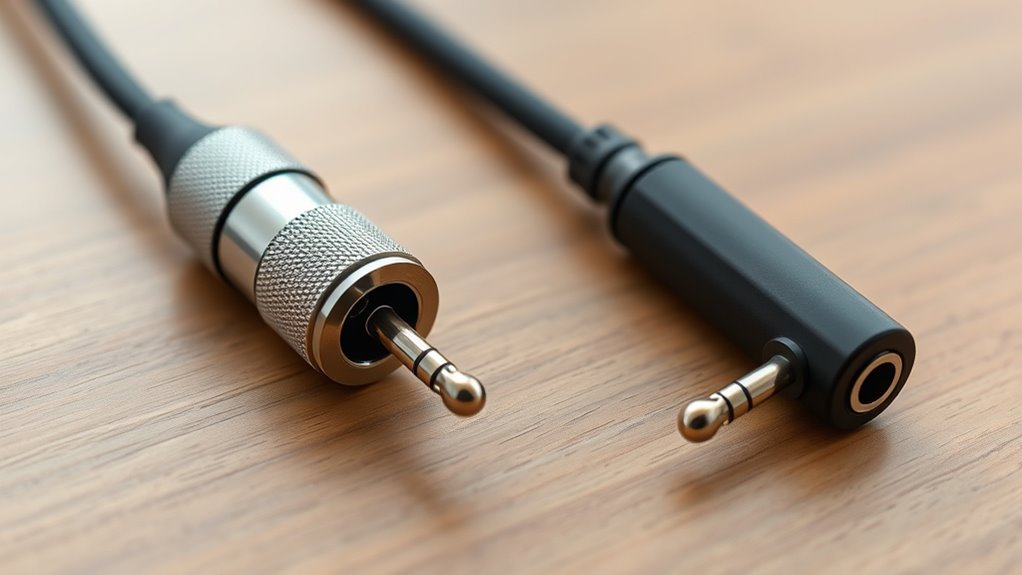
Balanced and unbalanced cables differ mainly in how they carry audio signals, which affects sound quality and interference resistance. Balanced cables use three conductors—hot, cold, and ground—allowing them to cancel out noise and deliver clearer sound. Unbalanced cables have two conductors—hot and ground—and are more susceptible to interference. When choosing between them, consider cable durability; balanced cables often have sturdier connectors, making them more resilient over time. Aesthetic preferences also play a role, as balanced cables tend to look more professional and sleek. Additionally, proper wiring is essential to ensure optimal performance and minimize interference in your audio setup. According to ethical hacking principles, proper wiring can be likened to secure network configurations that prevent vulnerabilities. Understanding these differences helps you decide which type suits your setup better, especially if you prioritize sound clarity, cable longevity, or the overall look of your audio equipment. For example, crochet styles for locs demonstrate how customization and protective styling can be enhanced with proper technique—similarly, correct wiring ensures your audio equipment functions at its best. Notably, grocery savings strategies can help you afford high-quality audio gear that utilizes these cables. Moreover, selecting the right cable type can also influence your overall audio experience, making it crucial to understand these technical distinctions.
How Do Balanced Cables Reduce Noise?
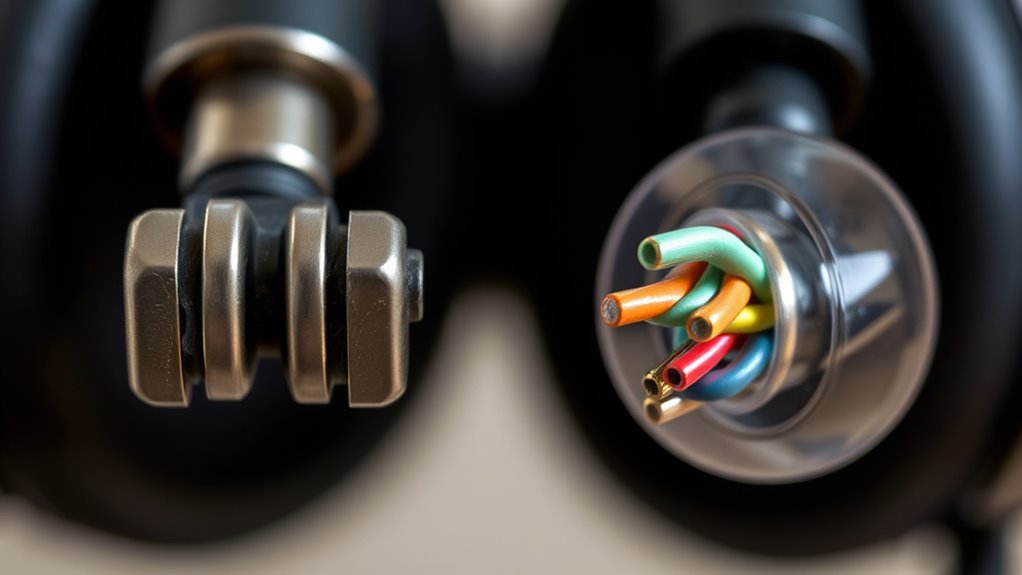
Balanced cables use differential signal transmission to send audio signals through two wires, which helps cancel out noise. When interference affects both wires equally, the cable’s design subtracts it out, reducing unwanted noise. This noise cancellation effect makes your headphones sound clearer and more detailed. Additionally, understanding how health factors like fatigue can impact audio perception emphasizes the importance of well-designed cables for optimal listening experiences. Moreover, cost considerations often influence the choice between balanced and unbalanced cables, affecting overall audio quality and investment. Recognizing the role of regional legal resources can also help consumers make informed decisions when selecting high-quality audio equipment. Furthermore, cable quality plays a significant role in maintaining consistent sound performance over time.
Differential Signal Transmission
When noise interference occurs, balanced cables help guarantee your audio stays clear by using differential signal transmission. This method sends two signals that are inverses of each other, so any external noise picked up equally affects both. Your equipment then subtracts one signal from the other, canceling out the noise and preserving audio fidelity. This process ensures that your sound remains pure and detailed, even in noisy environments. Additionally, balanced cables are designed for cable durability, making them more resistant to wear and tear over time. This robustness helps maintain consistent signal quality, ensuring your headphones deliver high-quality sound without deterioration. Furthermore, the use of proper shielding in balanced cables significantly reduces electromagnetic interference, enhancing overall audio clarity. Ultimately, differential signal transmission provides a reliable way to reduce noise while safeguarding your investment in premium audio gear.
Noise Cancellation Effect
Have you ever wondered how balanced cables effectively reduce noise in your headphones? They work by canceling out external interference through a process called common-mode rejection. Balanced cables send identical signals through two conductors, which are then subtracted at the receiver, eliminating noise. This results in clearer sound, especially in noisy environments, enhancing your listening experience. Proper wiring plays a crucial role in ensuring optimal noise cancellation and sound quality. Additionally, signal integrity can be maintained through meticulous wiring practices, further boosting audio clarity. Proper wiring techniques help preserve the electrical balance, which is essential for effective noise reduction. While wireless convenience appeals to many, some still prefer the aesthetic preferences and reliability of balanced cables. The table below captures emotions tied to noise cancellation:
| Feeling | Cause | Result |
|---|---|---|
| Frustration | Background noise | Distraction from music |
| Satisfaction | Noise-free listening | Pure audio enjoyment |
| Peace of mind | Reduced interference | Focus on sound details |
| Confidence | Reliable connection | Uninterrupted listening |
Common Uses of Unbalanced Cables in Headphones
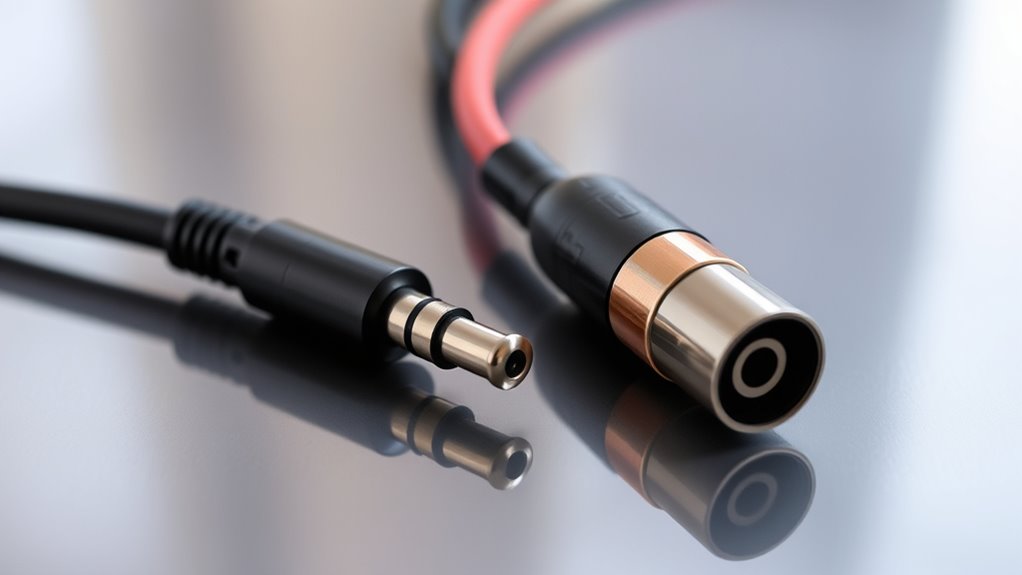
Unbalanced cables are commonly used in everyday headphone setups due to their simplicity and affordability. If you own wireless headphones, you might not encounter unbalanced cables often, but they are still prevalent in wired models. Many budget-friendly headphones rely on unbalanced connections because they are easier to design and cheaper to produce. Bluetooth connectivity, while wireless, often pairs with unbalanced analog connections in wired options, making these cables versatile. You’ll find unbalanced cables in many consumer headphones, especially for casual listening or travel. They’re convenient for connecting to smartphones, laptops, and portable audio devices. While they may not provide the highest sound fidelity, their simplicity and low cost make unbalanced cables a popular choice for everyday headphone use. Additionally, understanding the Power of Imagination can inspire innovative ways to improve audio technology and enhance user experience. Recognizing the importance of signal integrity can lead to better design choices that optimize sound quality even with unbalanced connections. Moreover, designers often prioritize cost-effective solutions to keep products accessible to a broad range of users.
Signal Quality and Sound Clarity Differences

You’ll notice that balanced cables often provide cleaner sound with less background noise, especially at higher volumes. This is because they reduce signal interference and minimize hum or static. As a result, your listening experience can become clearer and more detailed, making differences in sound quality more noticeable. Additionally, music therapy benefits can be better appreciated when using balanced cables, as the improved sound clarity enhances emotional expression and overall enjoyment. Furthermore, the reduction of electromagnetic interference is particularly advantageous when using high-quality sound design equipment, ensuring the integrity of audio signals.
Noise Reduction Benefits
Balanced cables typically deliver superior noise reduction, which directly enhances signal quality and sound clarity. This improved noise cancellation minimizes background hum and interference, allowing you to experience clearer, more detailed audio. Because balanced cables reduce electromagnetic interference, you notice less distortion and a cleaner sound overall. Additionally, the design of balanced cables often contributes to greater cable durability, meaning they’re less prone to damage over time. This durability ensures consistent noise reduction performance, even with regular use. With better noise cancellation and robust construction, balanced cables help you enjoy a more immersive listening experience. You’ll appreciate the enhanced clarity, especially in noisy environments, making the investment in balanced cabling worthwhile for audiophiles and casual listeners alike.
Signal Interference Impact
Signal interference can considerably impact audio quality, causing distortions, hums, and unwanted noise that detract from your listening experience. Ground loops are a common culprit, creating a constant hum due to differences in electrical potential between connected devices. Electromagnetic interference (EMI) from nearby electronics or power sources can also introduce static and crackling sounds, reducing sound clarity. Unbalanced cables are more susceptible to these issues because they lack the shielding and noise-canceling features of balanced cables. When interference occurs, it can muddy the audio, making it harder to distinguish subtle details in your music. To minimize these problems, opt for balanced cables when possible, especially in environments with lots of electronic devices, ensuring cleaner, clearer sound.
When Does Choosing a Balanced Cable Make a Difference?
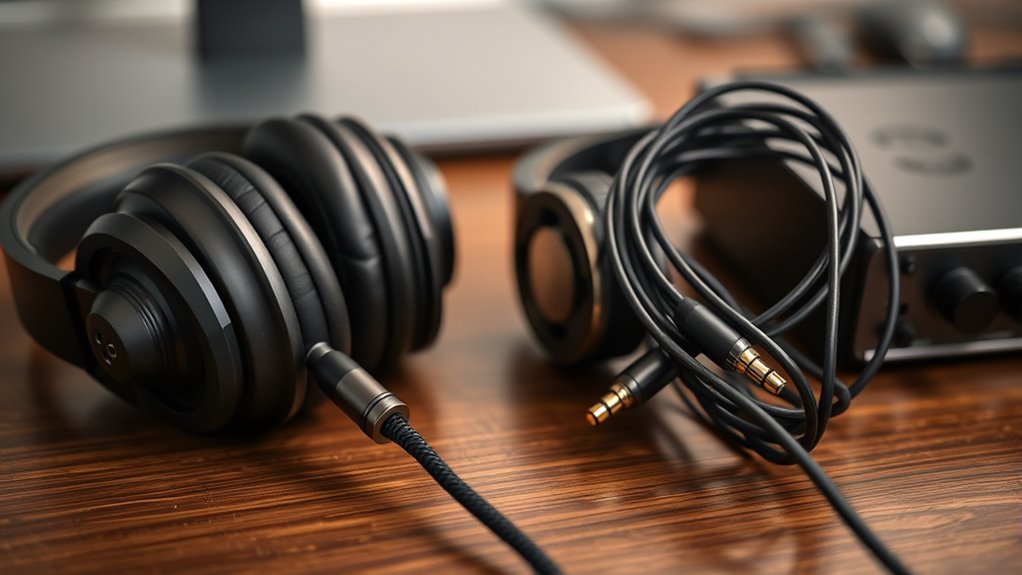
When deciding whether to use a balanced cable, it’s important to contemplate the specific context and equipment involved. Balanced cables make a difference when your audio setup supports them, especially if you need better noise rejection or higher sound quality. They’re also advantageous in environments with significant electrical interference. Additionally, consider cable durability; balanced cables often feature robust connectors and shielding, making them more resistant to wear and tear. Here’s a quick overview:
| When to Choose Balanced Cables | Why It Matters |
|---|---|
| Using high-end audio gear | Ensures ideal audio compatibility |
| Long cable runs | Reduces signal degradation |
| Noisy environments | Minimizes interference |
| Heavy usage | Offers greater cable durability |
If your setup supports these features, a balanced cable can truly improve your listening experience.
Cost and Compatibility Considerations
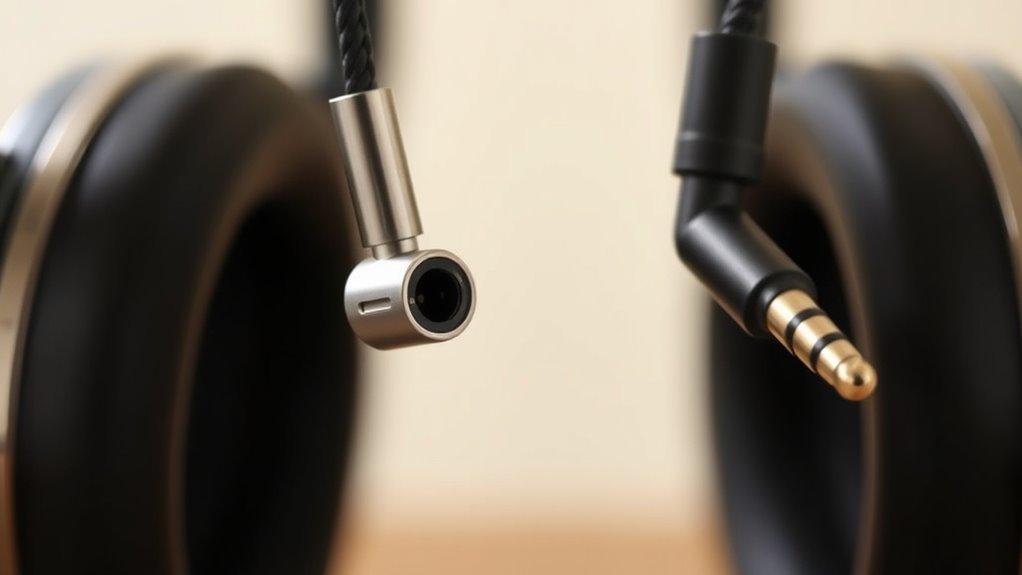
While balanced cables can enhance audio quality, they often come with higher costs and compatibility challenges. Balanced setups typically require specialized equipment, which can be expensive, making them less budget-friendly. Aesthetic considerations also play a role; balanced cables often have a bulkier design, which might not suit your style or setup. Additionally, not all brands support balanced connections, so compatibility with your existing gear could be limited. You might need to upgrade or replace certain components, increasing overall costs. If you’re on a tight budget or already invested in a specific brand ecosystem, unbalanced cables may be a more practical choice. Assess your equipment, aesthetic preferences, and budget before committing to a balanced cable setup to avoid unnecessary expenses and compatibility issues.
Practical Scenarios for Headphone Users
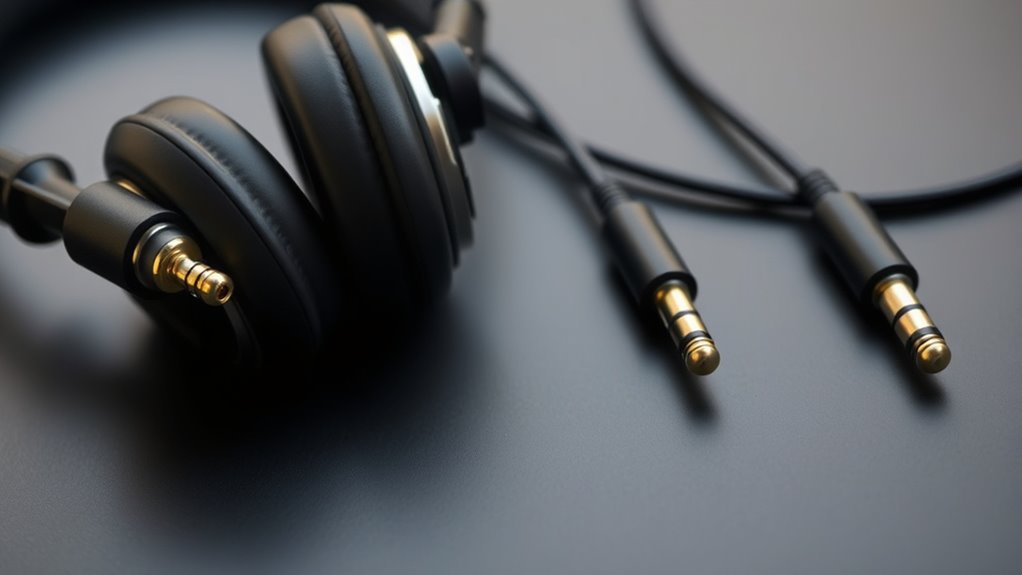
Choosing between balanced and unbalanced cables often depends on your specific listening environment and usage habits. If you mainly listen at home or in quiet settings, an unbalanced connection might suffice, especially with wireless headphones that reduce wire clutter. For gaming headsets used in noisy environments or for immersive gaming, a balanced cable can offer clearer sound and reduced interference. If you own high-end wired headphones, a balanced connection can maximize audio quality, especially with powerful amplifiers. On the other hand, if portability and convenience matter most, wireless headphones eliminate the need for cables altogether. Consider how often you move around or travel, and whether your setup benefits from a more stable, noise-resistant connection. Tailoring your choice to your lifestyle guarantees better sound and overall experience.
Making the Right Choice Based on Your Needs

To select the right cable type for your headphones, you need to evaluate your listening habits, environment, and audio priorities. If you’re often on the go or handle your gear frequently, prioritize cable durability to prevent breakage or wear. A sturdy, well-made cable ensures longevity and reliable performance. Conversely, if aesthetics matter to you, choose a cable with aesthetic appeal that complements your style and gear setup. Think about how much you value visual consistency or a sleek look. Consider where you’ll use your headphones most—studio, commuting, or casual listening—and match the cable’s durability and appearance accordingly. By balancing these factors, you’ll find a cable that fits your needs, enhances your experience, and lasts over time.
Frequently Asked Questions
Can I Upgrade My Unbalanced Headphones to Balanced Audio?
You can upgrade your unbalanced headphones to balanced audio, but it depends on your headphones’ design. If your headphones support balanced connections, switching can improve sound quality and reduce noise. Keep in mind, balanced cables often offer better cable durability and sound quality enhancement. However, you’ll need a compatible amplifier or DAC. Make sure your headphones are designed for balanced use; otherwise, the upgrade won’t deliver the expected benefits.
Are Balanced Cables Compatible With All Headphone Models?
Balanced cables aren’t compatible with all headphone models. You need to check the cable compatibility for your specific headphones, as some models are designed only for unbalanced connections. If your headphones have a standard single-ended jack, they likely won’t work with balanced cables without adapters or modifications. Always verify your headphone model’s specifications before attempting to upgrade or connect with balanced cables to confirm proper compatibility.
How Do Balanced Cables Affect Portable Headphone Use?
Using balanced cables on your portable headphones is like giving your sound a turbo boost. They can improve sound quality by reducing noise and interference, especially when you’re on the go. Plus, balanced cables tend to be more durable, standing up better to daily wear and tear. So, if you’re looking for clearer audio and longer-lasting cables, balanced options are worth considering for your portable setup.
Is There a Significant Difference in Battery Life With Balanced Cables?
You might wonder if balanced cables impact battery life. Generally, they don’t substantially affect power consumption, since their main advantage is improving signal integrity by reducing interference. However, some balanced setups could slightly increase power use due to additional components or circuitry. Overall, you won’t notice a big difference in battery life, but the improved signal quality might be worth it if you prioritize sound clarity and reduced noise.
Do Professional Audio Environments Always Require Balanced Cables?
Did you know that over 80% of professional studio setups and live sound reinforcement systems prefer balanced cables? In these environments, balanced cables are essential because they reduce noise and interference, ensuring clear audio. While not always mandatory, they considerably improve sound quality, especially over long runs. So, in professional settings, using balanced cables isn’t just a choice—it’s often a necessity for the best audio performance.
Conclusion
Choosing between balanced and unbalanced cables is like picking the right path through a noisy forest—balanced cables clear the path, reducing noise and revealing every detail, while unbalanced cables might leave you lost in static. If you crave crisp, pure sound, investing in the right cable can transform your listening experience into a vibrant, immersive journey. Make your choice wisely, and let your headphones be the guide through a world of pristine, unclouded audio.
Hello, I’m Art, and I’m excited to be a part of the 1Home Theatre Projector team. As a writer, I’m here to contribute my knowledge and insights to help you achieve the ultimate home cinema experience. I understand that making decisions in the world of home entertainment can be complex, and I’m here to simplify the process for you.
